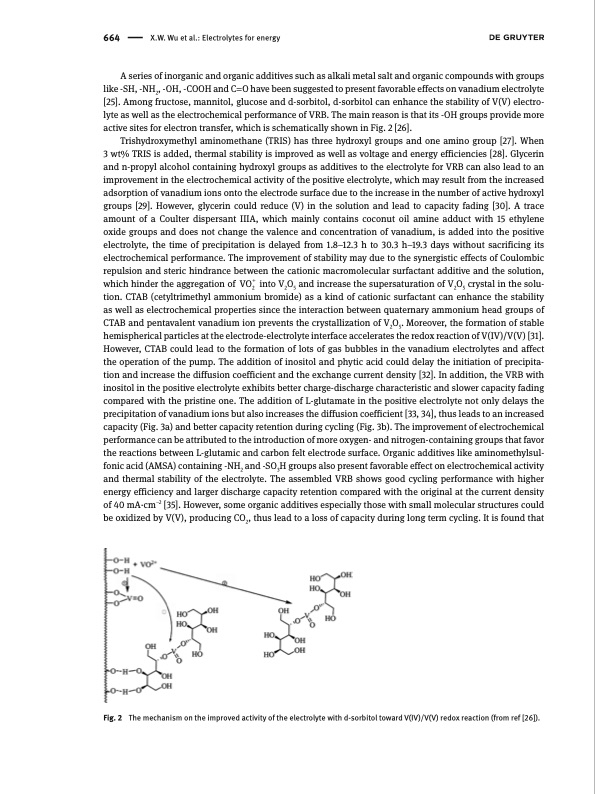
PDF Publication Title:
Text from PDF Page: 004
664 X.W. Wu et al.: Electrolytes for energy A series of inorganic and organic additives such as alkali metal salt and organic compounds with groups like -SH, -NH2, -OH, -COOH and C = O have been suggested to present favorable effects on vanadium electrolyte [25]. Among fructose, mannitol, glucose and d-sorbitol, d-sorbitol can enhance the stability of V(V) electro- lyte as well as the electrochemical performance of VRB. The main reason is that its -OH groups provide more active sites for electron transfer, which is schematically shown in Fig. 2 [26]. Trishydroxymethyl aminomethane (TRIS) has three hydroxyl groups and one amino group [27]. When 3 wt% TRIS is added, thermal stability is improved as well as voltage and energy efficiencies [28]. Glycerin and n-propyl alcohol containing hydroxyl groups as additives to the electrolyte for VRB can also lead to an improvement in the electrochemical activity of the positive electrolyte, which may result from the increased adsorption of vanadium ions onto the electrode surface due to the increase in the number of active hydroxyl groups [29]. However, glycerin could reduce (V) in the solution and lead to capacity fading [30]. A trace amount of a Coulter dispersant IIIA, which mainly contains coconut oil amine adduct with 15 ethylene oxide groups and does not change the valence and concentration of vanadium, is added into the positive electrolyte, the time of precipitation is delayed from 1.8–12.3 h to 30.3 h–19.3 days without sacrificing its electrochemical performance. The improvement of stability may due to the synergistic effects of Coulombic repulsion and steric hindrance between the cationic macromolecular surfactant additive and the solution, which hinder the aggregation of VO2+ into V2O5 and increase the supersaturation of V2O5 crystal in the solu- tion. CTAB (cetyltrimethyl ammonium bromide) as a kind of cationic surfactant can enhance the stability as well as electrochemical properties since the interaction between quaternary ammonium head groups of CTAB and pentavalent vanadium ion prevents the crystallization of V2O5. Moreover, the formation of stable hemispherical particles at the electrode-electrolyte interface accelerates the redox reaction of V(IV)/V(V) [31]. However, CTAB could lead to the formation of lots of gas bubbles in the vanadium electrolytes and affect the operation of the pump. The addition of inositol and phytic acid could delay the initiation of precipita- tion and increase the diffusion coefficient and the exchange current density [32]. In addition, the VRB with inositol in the positive electrolyte exhibits better charge-discharge characteristic and slower capacity fading compared with the pristine one. The addition of L-glutamate in the positive electrolyte not only delays the precipitation of vanadium ions but also increases the diffusion coefficient [33, 34], thus leads to an increased capacity (Fig. 3a) and better capacity retention during cycling (Fig. 3b). The improvement of electrochemical performance can be attributed to the introduction of more oxygen- and nitrogen-containing groups that favor the reactions between L-glutamic and carbon felt electrode surface. Organic additives like aminomethylsul- fonic acid (AMSA) containing -NH2 and -SO3H groups also present favorable effect on electrochemical activity and thermal stability of the electrolyte. The assembled VRB shows good cycling performance with higher energy efficiency and larger discharge capacity retention compared with the original at the current density of 40 mA·cm–2 [35]. However, some organic additives especially those with small molecular structures could be oxidized by V(V), producing CO2, thus lead to a loss of capacity during long term cycling. It is found that Fig. 2 The mechanism on the improved activity of the electrolyte with d-sorbitol toward V(IV)/V(V) redox reaction (from ref [26]).PDF Image | Electrolytes for vanadium redox flow batteries

PDF Search Title:
Electrolytes for vanadium redox flow batteriesOriginal File Name Searched:
10-1515_pac-2013-1213.pdfDIY PDF Search: Google It | Yahoo | Bing
Salgenx Redox Flow Battery Technology: Salt water flow battery technology with low cost and great energy density that can be used for power storage and thermal storage. Let us de-risk your production using our license. Our aqueous flow battery is less cost than Tesla Megapack and available faster. Redox flow battery. No membrane needed like with Vanadium, or Bromine. Salgenx flow battery
| CONTACT TEL: 608-238-6001 Email: greg@salgenx.com | RSS | AMP |